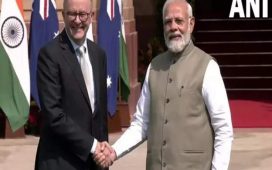Six product categories – petroleum, crude oil; coal, coke; diamond, precious metals; chemicals, pharma, rubber, plastics; electronics; and machinery – account for 82 per cent of India’s total merchandise imports.
“India’s merchandise imports for the fiscal year ending March 2023 are estimated to touch USD 710 billion, up from USD 613 billion in FY’2022, an increase of over 15.8 per cent over last year,” GTRI co-founder Ajay Srivastava said.
It said that the estimated value of petroleum imports is USD 210 billion and this includes crude oil, LNG and LPG.
“Crude imports grew by 53 per cent over the last fiscal. India bought crude from diversified countries. The top suppliers are Iraq (USD 36 billion), Saudi Arabia (USD 31 billion), Russia (USD 21 billion), UAE (USD 7 billion) USA (USD 11.9 billion). Imports from Russia increased by 850 per cent over last year,” it added.
The country’s coke and coal imports during 2022-23 are expected to touch USD 51 billion.
India imports both coking coal and thermal coal. While coking coal is used as raw material for making steel, thermal coal is used to generate electricity. It said that the coking coal imports may exceed USD 20.4 billion this fiscal, an 87 per cent increase over last year and steam coal imports may exceed USD 23.2 billion, a 105 per cent increase compared to last year.
Similarly, India’s diamond imports are estimated at USD 27.3 billion this fiscal, but of this most were exported and earned USD 24 billion for the country.
“India also exported most of the imported cut and polished diamonds. The reasons for such circular trading without adding value are not clear,” it added.
Further, it said that chemicals, pharma, plastics, and rubber account for USD 98.2 billion or almost 13.8 per cent of India’s imports.
Major imports are organic chemicals, including active pharma ingredients, fertilisers, and plastics.
“India imports 65-70 per cent of APIs from China. We must revive the API industry to ensure our country’s health security. This will require focus on not the top or penultimate product but the entire supply chain,” Srivastava said adding India must also remove any inverted duty conditions to set the plastics sector free.
Machinery, electronics, and telecom account for USD 135 billion or almost 20.4 per cent of India’s imports.
Regarding steel, metals, Ores, and minerals, the report said that India must watch out for subsidized imports as China, Korea, and Japan have excess capacities, and exports to the EU would be restricted because of carbon border taxes.
India imports mainly from countries including China, the UAE, the US, Saudi Arabia, Iraq, Russia, Indonesia, Singapore and South Korea.
“India has the highest deficit with China exceeding USD 87.5 billion. China’s 65 per cent of exports to India are in just three categories – electronics, machinery and Organic Chemicals. Other key import categories include plastics, fertilizers, medical, and scientific instruments,” it added.
The commerce ministry is expected to release the official figures for exports and imports for 2022-23 by mid of April.
During April-February 2022-23, imports rose to USD 653.47 billion as against USD 549.96 billion during the period April-February 2021-22.







